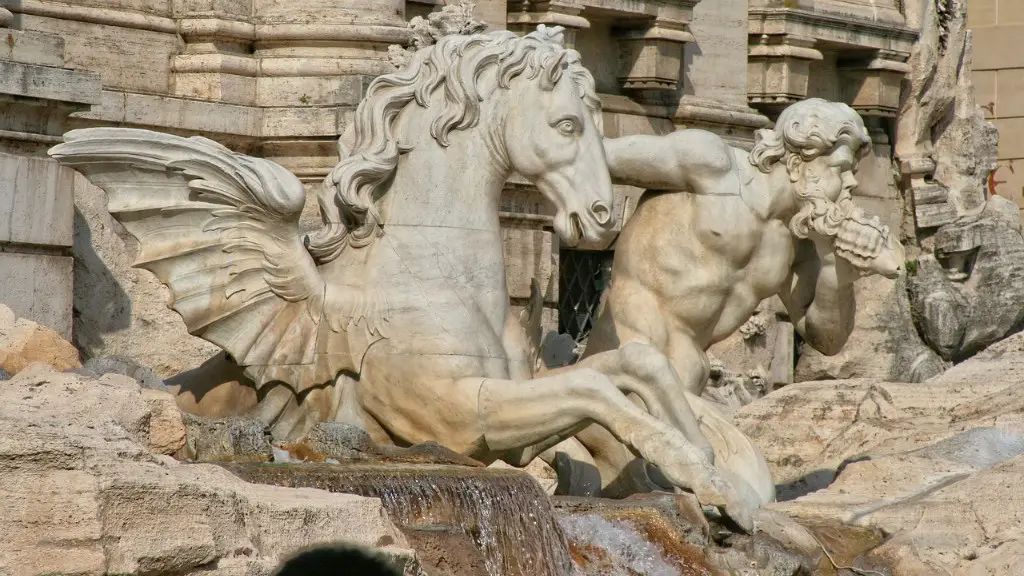The Roman Empire was considered one of the most prominent civilizations of the ancient world. Throughout its history, it developed a complex and sophisticated way of life. There were many rituals and ceremonies associated with its culture that required Romans to dress in certain attire. In terms of clothing, two types of clothing stand out as some of the most prominent clothing styles worn by ancient Romans: togas and stolas.
Togas were a type of Roman clothing worn by citizens, both men and women. Typically, togas were garments made from one large piece of fabric that was draped over the body. Men typically wore white togas, while women wore garments of a different colour. The most important feature of the toga was its colour and stripes, as they were associated with one’s status in Roman culture. For instance, a toga with broad purple stripes indicated an individual was from a noble family, while a toga with narrow stripes indicated one was from a lower social class.
Stolas were another form of ancient Roman clothing. Unlike togas, which were thought to be more for ceremonial purposes, stolas were more practical garments and could be worn for everyday occasions. Stolas were made from two pieces of fabric; one piece was worn over both shoulders, while the other piece was longer and draped across the body. Women often wore them in colors such as red, yellow and pink, combined with various adornments like laces and tassels. Stolas were considered very fashionable in the ancient world and were often used to signify a woman’s elegance and beauty.
The two types of clothing worn by ancient Romans, togas and stolas, demonstrate how the tendencies of fashion today were similar to those of dress in the ancient world. Both of these garments were used to indicate social standing and wealth, as well as to signify beauty and elegance. As fashion goes, clothing styles eventually change and evolve, but it is clear that the aesthetics of dress in the ancient world had a great influence on the clothing styles of today.
The Role of Decoration in Ancient Roman Clothing
In ancient Roman society, it was common for individuals to decorate their clothing with various materials and fabrics. A variety of adornments such as laces and tassels were often used to add to the attractiveness of the clothing. Decorative materials like gold and silver embroidery, as well as precious gems, were also used to embellish clothes. These decorations could signify status in Roman culture, with more decorations indicating a higher social standing. In addition, many individuals would use dye and paint to add color to their clothing.
Another way that Roman clothing was ornamented was through the use of symbols. Symbols, such as the she-wolf, eagle and winged figure Giunone, were used to express cultural identity and religion within the Roman Empire. Many of these symbols still exist today, providing insight into Roman thought and culture.
Ancient Roman art contains numerous examples of paintings and statues depicting individuals in togas or stolas. These images demonstrate how important clothing was in Roman culture, as it could indicate one’s social standing, while also indicating one’s wealth and beauty. By examining these works of art, it is possible to gain a better understanding of how people in the ancient Roman world dressed and ornamented their clothing.
The Influence of Ancient Roman Clothing Styles
The clothing styles of Ancient Rome have had a significant influence on modern clothing styles. The toga is a well-known garment to many people, and its influence can still be seen in contemporary fashion. It is often used as a costume in films and plays, and it is also worn by individuals in special occasions or ceremonies.
The influence of stolas can also be seen in modern fashion. They often have a softer, more feminine shape, which has been adopted in many contemporary women’s clothing styles. Furthermore, the idea of embellishing garments with decorative materials and symbols still exists today, although the trends have changed.
Overall, the fashion styles of Ancient Rome have had a significant influence on modern fashion. From togas to stolas, the clothing of ancient Roman society has left its mark on modern clothing styles.
The Impact of Ancient Roman Clothing on Society
In ancient Roman society, clothing had an important symbolic value. It could indicate one’s social standing and wealth, while also signifying beauty and elegance. This was especially important for women, since the clothing they wore could influence how they were perceived by society.
The use of symbols in clothing was also a significant factor in Roman culture. These symbols would often represent a person’s beliefs and affiliations, providing insight into their identity. Furthermore, clothing could also be used to signify religious beliefs, as there were often official garments associated with different deities.
Moreover, clothing in Ancient Rome could also be used for self-expression. Although Roman society was highly stratified, certain individuals could often express themselves through their clothing styles. This can be seen in the works of art from the period, which show individuals wearing different types of clothing.
Conclusion
In conclusion, clothing was an important part of Ancient Roman culture. Togas and stolas were two of the main garments worn by men and women in Roman society, and they often bore various decorations and symbols. These garments had a great influence on today’s fashion styles, as well as on society itself. Ancient Roman clothing symbolized status and wealth, but it also provided individuals with an opportunity to express themselves and their beliefs.



